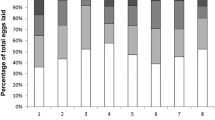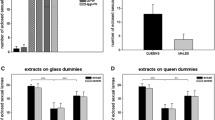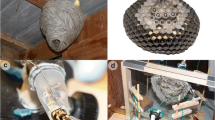Summary
The influence of various social factors on the production of males was investigated in the Argentine ant,Iridomyrmex humilis.
In this polygynous species, the workers which are monomorphic are unable to lay reproductive eggs, so all the males are the progeny of the queens.
Although male eggs appear to be laid by mated queens throughout the year, in large stock colonies males are reared periodically (every 3 or 4 months); males develop from brood taken from these colonies at any point in the cycle and given queenless or queenright (1 to 5 queens) units. This is in striking contrast to many other species of ants where it is generally assumed that male eggs are laid seasonnally.
Comparative experiments suggest that several related factors influence the rearing of males as far as the pupal stage.
-
•Worker/larva ratio: The proportion of male larvae developing in standardized units in which the worker/larva ratio was varied from 0.25 to 25 demonstrated that low ratios inhibit male production.
-
•Queen influence: In standardized units where the worker/larva ratio was high the presence of queens did not inhibit the rearing of males suggesting that there is no queen inhibitory pheromone controlling male experimental production. Data suggest evidence that queens prevent male production by means of appropriation of food.
-
•Diet: Male larvae failed to pupate in experimental societies deprived of protein. Thus, the production of males appears to be controlled by the amount of food available to larvae. This depends on foraging activity, the quantity of brood in relation to the number of workers and the number of queens in the society.
Resume
L'objectif de ce travail est de fournir des données concernant la production des mâles au laboratoire.
Chez cette espèce les ouvrières sont incapables de pondre des œufs reproducteurs; en conséquence tous les mâles sont les descendants des reines.
Dans les grosses sociétés stocks maintenues au laboratoire, les mâles sont élevés avec une périodicité de 3 à 4 mois. Dans l'intervalle, le couvain transféré des sociétés stocks dans des unités standardisées pourvues ou non de reines (1 à 5 reines) est à l'origine de nouveaux mâles. Il paraît donc raisonnable de penser que des œufs mâles sont pondus en permanence par les reines tout au long de la période d'activité. Cette observation est différente de celle que l'on fait habituellement chez la plupart des autres fourmis où il est généralement admis que les œufs mâles sont pondus à un moment déterminé du cycle annuel. On peut dès lors se demander pourquoi le développement des œufs mâles n'est pas continu mais au contraire intervient périodiquement.
Des expériences comparatives suggèrent que l'élevage du couvain mâle jusqu'au stade nymphal dépend de plusieurs paramètres reliés entre eux.
-
Le ratio ouvrières/larves: nous avons enregistré la production des mâles dans des unités standardisées où le ratio ouvrières/larves varie de 0,25 à 25. Plus la valeur du ratio est élevée, plus on obtient de larves mâles.
-
Le contrôle royal: dans des unités standardisées où le ratio ouvrières/larves est élevé, la présence des reines n'est pas un obstacle à l'élevage des mâles. Ces données suggèrent l'absence d'une phéromone royale inhibitrice contrôlant la production des mâles. Il semble plutôt que les reines entravent le développement des mâles par le biais d'une appropriation de nourriture.
-
Le régime alimentaire: des sociétés expérimentales soumises à un jeûne protidique cessent de produire des mâles. Il semble donc bien que le développement des mâles soit essentiellement contrôlé par la quantité de nourriture disponible. Si cette quantité vient à baisser à cause d'une diminution de l'approvisionnement, d'un couvain trop abondant ou d'un nombre de reines trop élevé, les ouvrières réagissent en cessant d'élever les larves mâles.
Similar content being viewed by others
References
Bartels P. J., 1983. — Polygyny and the reproductive biology of the Argentine ant.Ph. D., University of California, Santa Cruz, 205 p.
Benois A., 1973. — Incidence des facteurs écologiques sur le cycle annuel et l'activité saisonnière de la fourmi d'ArgentineIridomyrmex humilis Mayr (Hymenoptera, Formicidae) dans la région d'Antibes.Insectes Soc., 20, 267–296.
Bier K., 1954. — Ueber den Einfluss der Königin auf die Arbeiterinnen-Fertilität im Ameisenstaat.Insectes Soc., 1, 7–19.
Brian M. V., 1980. — Social control over sex and castes in bees, wasps and ants.Biol. Rev., 55, 379–415.
Brian M. V., 1981. — Treatment of male larvae in ants of the genusMyrmica.Insectes Soc., 28, 161–166.
Crozier R. H., 1971. — Heterozygosity and sex determination in haplo-diploidy.Amer. Natur., 1905, 399–412.
Edwards J. P., 1987. — Caste regulation in the Pharaoh's antMonomorium pharaonis: the influence of queens on the production of new sexual forms.Physiol. Entomol., 12, 31–39.
Ehrhardt H. J., 1970. — Die Bedeutung von Königinnen mit steter arrhenotoker Parthenogenese für die Männchenerzeugung in den Staaten vonFormica polyctena Foerster (Hym. Form.).Dissertation, Nat. Fak., Würzburg, 106 pp.
Evesham E. J., 1985. — The interaction of food distribution and the caste composition of an ant colony (Myrmica rubra L.).J. Zool. Lond., 207, 241–250.
Fletcher D. J., Ross K. G., 1985. — Regulation of reproduction in eusocial Hymenoptera.Ann. Rev. Entomol., 30, 319–343.
Giraud L., 1982. — Contribution à l'étude de la biologie d'Iridomyrmex humilis (Hym. Dolichoderidae). Principes d'une lutte intégrée.Thèse 3 e cycle, Université Paris V, 153 p.
Giraud L., 1983. — Rôle inhibiteur du facteur «groupement de reines» sur l'apparition des mâles chezIridomyrmex humilis, Hymenoptera, Dolichoderinae.C. R. Acad. Sc., Paris, 296, série III, 655–58.
Hölldobler B., Wilson E. O., 1977. — The number of queens: an important trait in ant evolution (Hym. Formicidae).Naturwissenschaften, 64, 8–15.
Keller L., 1985. — Etude de la monogynie expérimentale et de ses implications chez une espèce de fourmis polygynes (Iridomyrmex humilis, Mayr).Diplôme de biologiste, Université de Lausanne, 63 p.
Keller L., 1988. — Evolutionary implications of polygyny in the Argentine ant,Iridomyrmex humilis (Mayr.) (Hymenoptera: Formicidae): an experimental study.Anim. Behav., 36, 159–165.
Keller L., Passeral L., 1988. — Energy investment in gynes of the Argentine antIridomyrmex humilis (Mayr.) in relation to the mode of colony founding in ants (Hymenoptera: Formicidae).Intern. J. Invert. Reprod. Dev., 13, 31–38.
Marchal P., 1917. — La fourmi d'Argentine (Iridomyrmex humilis Mayr).Bull. Soc. Et. vulg.Zool. Agric., Bordeaux,16, 23–26.
Markin G. P., 1968. — Nest relationship of the Argentine Ant,Iridomyrmex humilis (Hymenoptera, Formicidae).J. Kans. Entomol. Soc., 41, 511–516.
Markin G. P., 1970a. — The seasonal life cycle of the Argentine Ant,Iridomyrmex humilis (Hymenoptera, Formicidae) in Southern California.Ann. Entomol. Soc. Amer., 63, 1238–1242.
Markin G. P., 1970b. — Food distribution within laboratory colonies of the Argentine ant,Iridomyrmex humilis (Mayr).Insectes Soc., 17, 127–158.
Newell W., Barber T. C., 1913. — The Argentine ant.USDA Bureau of Entomology Bull., 122, 98 p.
Passera L., 1977. — Peuplement myrmécologique du cordon littoral du Languedoc-Roussillon. Modifications anthropiques.Vie et Milieu, 27, sér. C, 249–265.
Passera L., 1984. —L'organisation sociale des Fourmis. Privat édit., Toulouse, 360 p.
Passera L., Keller L., 1987. — Energy investment during the differentiation of sexuals and workers in the Argentine antIridomyrmex humilis.Mitt. Schweiz. Entomol. Gesells, 60, 249–260.
Peacock A. D., 1950. — Studies in Pharaoh's antMonomorium pharaonis (L.). 2. Methods of recording observations on artificial colonies.Ent. Month. Mag., 86, 129–135.
Peacock A. D., Smith I. C., Hall D. W., Baxter A. T., 1954. — Studies en Pharaoh's antMonomorium pharaonis (L.) 8. Male production by parthenogenesis.Ent. Month. Mag., 90, 154–158.
Petersen-Braun M., 1975. — Untersuchungen zur sozialen Organisation der PharaoameiseMonomorium pharaonis (L.) (Hymenoptera, Formicidae). 1. Der Brutzyklus und seine Steuerung durche Populationseigene Faktoren.Insectes Soc., 22, 269–292.
Petersen-Braun M., 1977a. — Studies on the endogenous breeding cycle inMonomorium pharaonis (L.) (Formicidae).Proc. 8th Int. Congr. IUSSI, Wageningen, 211–212.
Petersen-Braun M., 1977b. — Untersuchungen zur sozialen Organisation der PharaoameiseMonomorium pharaonis (L.) (Hymenoptera, Formicidae). 2. Die Kastendeterminierung.Insectes Soc., 29, 164–174.
Ross K. G., Fletcher D. J., 1985. — Genetic origin of male diploidy in the fire antSolenopsis invicta (Hymenoptera: Formicidae) and its evolutionary significance.Evolution, 39, 888–903.
Schmidt G. H., 1972. — Männchendetermination in polygynen Waldameisenstaat.Zool. Anz., Leipzig, 189, 159–169.
Schmidt G. H., 1974. — Mechanismen der Kastenbildung und Steuerung des Geschlechts-verhältnisses, 766–806.In G. H. Schmidt (ed.)Sozialpolymorphismus bei Insekten. Wiss. Verlagsges, Stuttgart.
Smeeton L., 1981. — The source of males inMyrmica rubra L. (Hym. Formicidae).Insectes Soc., 28, 263–278.
Vargo E. L., Fletcher D. J., 1986. — Evidence of pheromonal queen control over the production of male and female sexuals in the fire antSolenopsis invicta.J. Comp. Physiol., A159, 741–749.
Yamauchi K., Kinomura K., Miyakes S., 1982. — Sociobiological studies of the polygynic antLasius sakagami. II. Production of colony members.Insectes Soc., 24, 303–318.
Author information
Authors and Affiliations
Rights and permissions
About this article
Cite this article
Passera, L., Keller, L. & Suzzoni, J.P. Control of brood male production in the Argentine antIridomyrmex humilis (Mayr). Ins. Soc 35, 19–33 (1988). https://doi.org/10.1007/BF02224135
Received:
Accepted:
Issue Date:
DOI: https://doi.org/10.1007/BF02224135




